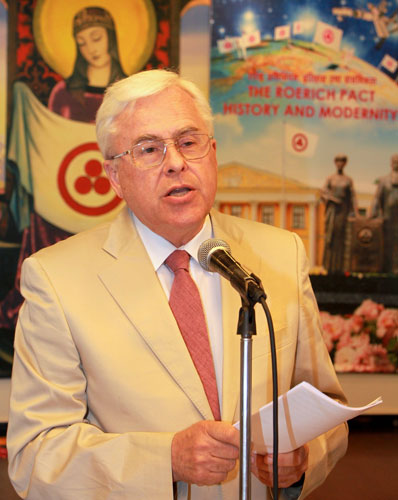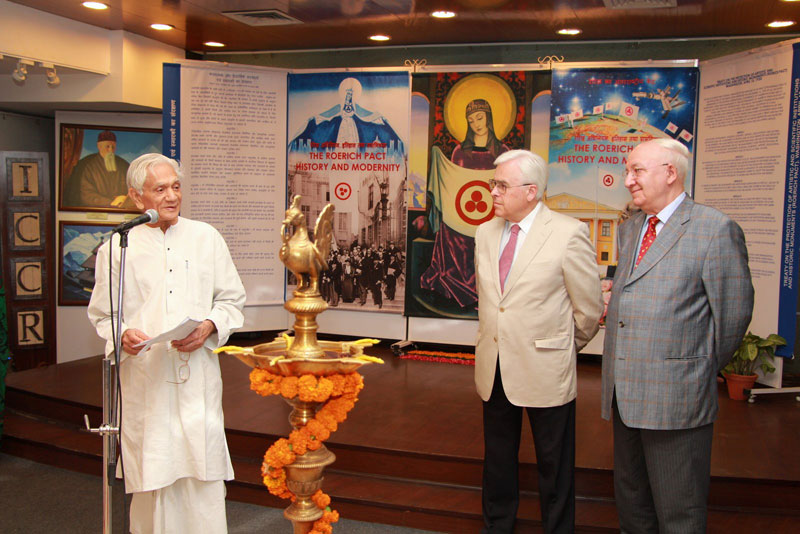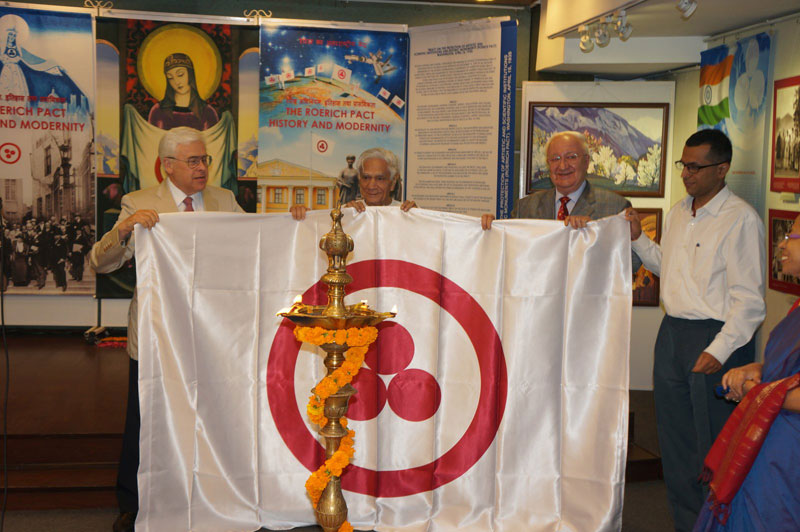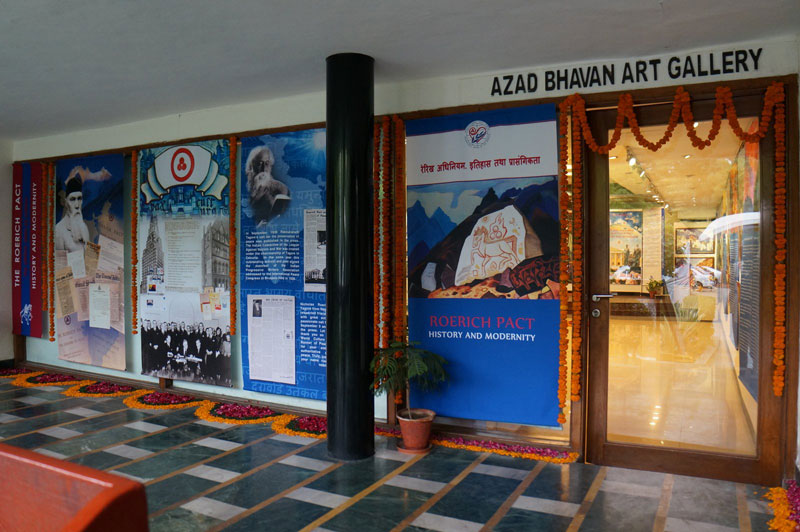The Exhibition Project “The Roerich Pact. History and Modernity” continues its tour around India
On May 15 the exhibition opened in the capital of India New Delhi, in the Azad Bhavan Art Gallery of the Indian Council for Cultural Relations (ICCR).
 |
Prof. Lokesh Chandra, President of the ICCR and a renowned scholar of Buddhism, Mr. Alexander Losyukov, President of the International Centre of the Roerichs (ICR), Moscow and a famous Russian diplomat, Alexander Kadakin, Ambassador of the Russian Federation to the Republic of India, and Dinkar Astana, Executive Director of the ICCR took part in the grand opening of the exhibition, which included the Indian traditional ceremony of lighting an oil lamp.
 | |
In his welcome address the President of the ICR Alexander Losyukov noted that nowadays the Roerich Pact on the protection of cultural properties not only does not lose its significance but is even becoming all the more relevant. “This exhibition, which started in Paris in 2012 and has already displayed in many countries, including the UN headquarters in New York, is supposed to actively unite world community for the sake of implementation of the ideals that Nicholas Roerich made the cornerstone of his document. Moreover, like in the World War I tragedy – even on a much broader scale – treasures of world culture perish in large quantities. To our horror, it happens today, too, right before our eyes.”
In his speech Prof. Lokesh Chandra reminded the gathering that India supported Roerich’s idea to develop an international legal document on the protection of cultural properties during armed conflicts. In 1946 the All-India Conference for Cultural Unity extended its support to the Pact and in 1948 it was adopted by the Government of India headed by the first Prime Minister of India Jawaharlal Nehru.
A renowned Tibetan scholar, historian and philosopher, Dr. Lokesh Chandra is widely known among the scholars of Buddhist culture. The knowledge of more than 20 languages including Sanskrit, Tibetan and Ancient Greek has given him access to many rare texts. He has authored and edited more than three hundred books including Tibetan-Sanskrit Dictionary, works on the history of Tibetan literature, studies in Indo-Asian art and culture, Mongolian Ganjur in 108 volumes and the Dictionary of Buddhist Iconography in 15 volumes.
 | |
It is noteworthy that Prof. Lokesh Chandra’s father, the outstanding Indian scholar Raghu Vira who became his first teacher, was closely associated with the Roerich family and shared their academic interests, which is clear from the extant letters addressed to him by George Roerich (1954-1955). These professional and friendly relations have to a great extent defined the direction of Lokesh Chandra’s research activities. One of Raghu Vira’s works published in the ICR commemoratory volume George Roerich’s Centenary was titled The Trails of George Roerich. On the same trails Lokesh Chandra met the writer and scholar of India Lyudmila Shaposhnikova who has been Director General of the Museum Named after Nicholas Roerich, Moscow since 1989. One of the chapters of her work On the Master’s Trail opens with the following words: “The map of Shambhala was drawn in Lokesh Chandra’s garage...” From the same chapter we learn that the young Indian professor not only studied Tibetan culture but was directly involved in its salvaging and did everything in his power to preserve ancient knowledge and bring it to the world.
“Nicholas Roerich and his sons were deeply anguished by the condition of culture, and that anguish became the poem of their quest, the poem of humanity” — said Lokesh Chandra in his address. He added that “the Roerich Pact is a dream of entire humanity and also a quest for essence.”
Alexander Kadakin, Ambassador of the Russian Federation to the Republic of India and Vice President of the International Roerich Memorial Trust in his turn expressed hope that “the exhibition would become one more stimulus behind the development and preservation of the Roerich Estate in the Himalayan Kullu valley and turning it into the focal point of the Indo-Russian cultural cooperation and the memorial, research and educational center of the world standard.”
 |  |
The exhibition will remain on display in New Delhi till May 27. It has already travelled around North India and visited Shimla (State of Himachal Pradesh), Chandigarh (Sates of Haryana and Punjab) and Gandhinagar (State of Gujarat). A similar permanent exhibition is on display in the premises of the Urusvati Himalayan Research Institute in the Roerich Estate in Naggar. The organizers of the exhibition hope to bring it to South India shortly.
The grand opening of the exhibitions was attended by renowned Indian scholars, public figures, foreign diplomats, artists, students, Roerich movement activists from India, journalists and media representatives.
 | |
By way of background, the objective of the ICRC is propagation of the unique cultural and spiritual heritage of India, implementation of policies and programmes pertaining to India’s external cultural relations; fostering and strengthening of cultural relations and mutual understanding between India and other countries. ICCR was founded in 1950 by the first Education Minister of independent India Maulana Abdul Kalam Azad who also was one of the leaders of Indian independence movement, champion of Hindu-Muslim unity and a renowned scholar. Therefore, the ICCR headquarters bear his name: Azad Bhavan (lit. Azad’s Palace)
ADDRESS OF THE PRESIDENT OF THE INTERNATIONAL CENTRE OF THE ROERICHS, AMBASSADOR ALEXANDER LOSYUKOV, AT THE INAUGURATION OF THE EXHIBITION “ROERICH PACT. HISTORY AND MODERNITY”
New Delhi, Azad Bhavan Gallery, May 15, 2015
It is both honour and pleasure for us, representatives of the Russian public organization, ICR, to open this Exhibition today in New Delhi, the capital of friendly India which for many decades was second home for our outstanding compatriots, the unique family of the Roerichs. I would like in the first place to say thanks to those who made this opening possible, to be precise, to the Indian Council for Cultural Relations and personally to the world’s prominentBuddhologist, Dr Lokesh Chandra, the Azad Bhavan staff and, last but not least, to the Russian Embassy and Ambassador Kadakin.
Our exhibition is timed to the jubilees when the world celebrates two important events – the 70th Anniversary of the end of the Great Patriotic War and the 70th Anniversary of the creation of the United Nations. One can trace an obvious relation between those two events and the theme of our Exhibition. After all the Roerich Pact was in first place aimed at prevention of the threat of war and unification of the world community in the interests of peace and preservation of the world culture.
On April 15, 1935, representatives of 21 countries of the Pan American Union signed in the White House in Washington history’s first treaty creating internationally binding conditions for preservation of humankind’s cultural heritage in the periods of armed conflicts as well as in time of peace. The said Treaty was initiated and promoted by our compatriot, an outstanding scientist and philosopher, artist and public figure – Nikolai Roerich. He was devoted to this ideasince before World War I. For thirty years, he performed huge work, mostly alone,mobilizing broad circles of world public in support of this initiative. Nikolai Roerich was not the first in history to understand the necessity of joining efforts of political, public, scientific and other strata of the world community for the cause ofdefending cultural monuments. However, he brought this idea to practicalimplementation. Due to his high authority in the world earned by hard labour, persistence in reaching a goal, his spiritual power and ability to foresee the future,the international community made its first, though small, but so important step towards creating a system of saving rich spiritual and material heritage endowed to us by previous generations. Nikolai Roerich was convinced that without respect forand preservation of its history at present, the human race could not hope for adecent life in the future.
The efforts of the great man and his coworkers were crowned with success. The feat of this man was not a single surge of heroism. It was a cause to pursueand the result of his entire life. His decisiveness and persistence in pursuing the goal correlated with his philosophical comprehension of processes unfolding in the universe and their projection of the Earth’s realities.
He was one of the breed of very known and, at times, regretfully, less known human beings whom we call the Teachers, guides of humankind. The task of preserving its heritage he was solving within the context of even broader and more complicated problem that he had before him for the duration of whole his life – promotion of peace on earth through support and every possible elevation of the cultural level of people. Exactly along these lines, he saw the road towardscessation of hostilities and wars and prosperity for the human race. “Peace through Culture”, this motto of the outstanding Russian figure, remains absolutely up to date and is equally acclaimed today, 80 years later. I regret to say that almost a century since those days we are again searching for effective ways and means tocombat the threat of war and for methods to settle international and interstate problems and discords. So much to say about the progress of human civilization.
Nikolai Roerich’s major efforts aimed at elaborating and signing of the Pact fell mainly on the post-World War I period. They were enthusiastically acclaimedby many outstanding figures of the world’s political scene and the public. However, it was only in 1935 that it became possible to sign it. The clouds of a next world conflict were already rapidly gathering over Europe and the world.Guided by a premonition of a looming catastrophe, Roerich, as he did it before World War I, created a series of paintings-warnings. Moreover, like in the first world tragedy – even on a much broader scale – treasures of world culture perished in large quantities. To our horror, it happens today, too, right before our eyes.
This is why exactly today it is so important to remember and learn the lessons of history and once again to pay tribute to the selfless mission of our great compatriot. We should pay tribute also to the wisdom of those prominent figures of culture and science and leaders of states who supported Roerich’s appeal in that complicated prewar environment and signed the Pact or joined it later. Now, as never before it should not be forgotten that a mechanistic civilization alone,whatever heights it may reach, cannot provide a decent future for humanity. The real road to it lies through Love, Spirituality and Beauty united by the all-embracing concept of Culture. One cannot attain genuine Culture by destroying and thinning the fragile spiritual cocoon of our life, which a cultural heritage in real terms presents. Fight for Culture not as an entertainment but as a basic component of human existence is of no less importance today than fight for peace and disarmament. We have to comprehend clearly that through enlarging the space for Culture we are reducing the space of war, and vice versa. This is exactly whatthe Roerich Pact story is about.
This Exhibition project was started by Moscow’s International Centre of the Roerichs two years ago with a similar exhibition presented at the Headquarters of UNESCO. A month ago, the same Exhibit was opened at the UN Building in New York. Just a few days ago, UNESCO Director-General, Ms Irina Bokova, visitedour Centre and Museum in Moscow. We agreed to wind up the project at the UNESCO Headquarters in Paris in April next year. We want to report to UNESCO on the show of this Exhibition in many countries of Europe, Asia and America as well as in dozens of Russian cities, too. Today in New Delhi, we open the Exhibition specially prepared for India.
By this project, we hope to contribute to the efforts of world public andinternational organizations aimed at strengthening peace and security. It is only in conditions of peace that we can preserve the world’s cultural heritage. Only byreally preserving it, can humankind guarantee its own survival.
Let us bow again today to Nikolai Roerich and those wise people, the Teachers, who not once in human history taught us useful lessons and showed us the right direction.